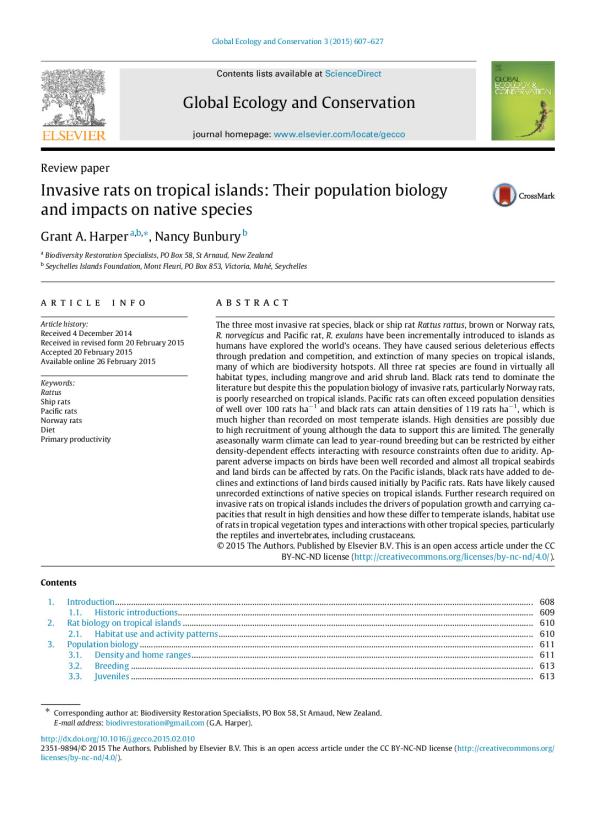Location
SPREP LIBRARY
Publisher
Global Ecology and Conservation
Publication Year:
2015
Publication Place
New Zealand
Physical Description:
21 p.
Call Number
[EL]
Material Type
Language
English
Record ID:
436
Legacy PEIN ID:
81888
General Notes
© 2015 The Authors. Published by Elsevier B.V. This is an open access article under the CC BY-NC-ND license (http://creativecommons.org/licenses/by-nc-nd/4.0/).
Available online
Subject Heading(s)
Invasive species - Management - Global
Invasive rats - Impacts
Abstract
The three most invasive rat species, black or ship rat Rattus rattus, brown or Norway rats, R. norvegicus and Pacific rat, R. exulans have been incrementally introduced to islands as humans have explored the worlds oceans. They have caused serious deleterious effects through predation and competition, and extinction of many species on tropical islands, many of which are biodiversity hotspots. All three rat species are found in virtually all habitat types, including mangrove and arid shrub land. Black rats tend to dominate the literature but despite this the population biology of invasive rats, particularly Norway rats, is poorly researched on tropical islands. Pacific rats can often exceed population densities of well over 100 rats ha?1 and black rats can attain densities of 119 rats ha?1, which is much higher than recorded on most temperate islands. High densities are possibly due to high recruitment of young although the data to support this are limited. The generally aseasonally warm climate can lead to year-round breeding but can be restricted by either density-dependent effects interacting with resource constraints often due to aridity. Apparent adverse impacts on birds have been well recorded and almost all tropical seabirds and land birds can be affected by rats. On the Pacific islands, black rats have added to declines and extinctions of land birds caused initially by Pacific rats. Rats have likely caused unrecorded extinctions of native species on tropical islands. Further research required on invasive rats on tropical islands includes the drivers of population growth and carrying capacities that result in high densities and how these differ to temperate islands, habitat use of rats in tropical vegetation types and interactions with other tropical species, particularly the reptiles and invertebrates, including crustaceans.
Location
SPREP LIBRARY
Publisher
Global Ecology and Conservation
Publication Year:
2015
Publication Place
New Zealand
Physical Description:
21 p.
Call Number
[EL]
Material Type
Language
English
Record ID:
436
Legacy PEIN ID:
81888
General Notes
© 2015 The Authors. Published by Elsevier B.V. This is an open access article under the CC BY-NC-ND license (http://creativecommons.org/licenses/by-nc-nd/4.0/).
Record Created: 15-Aug-2018
Record Modified: 15-Feb-2022

